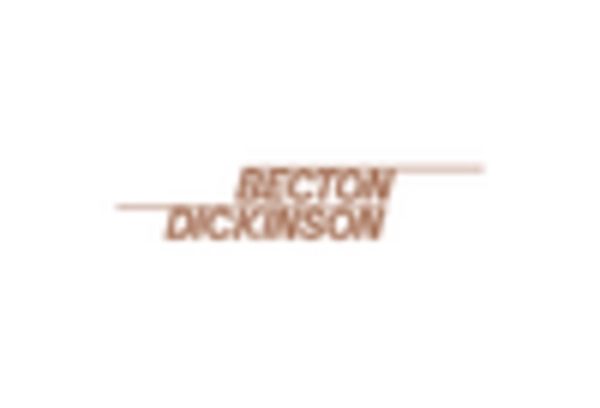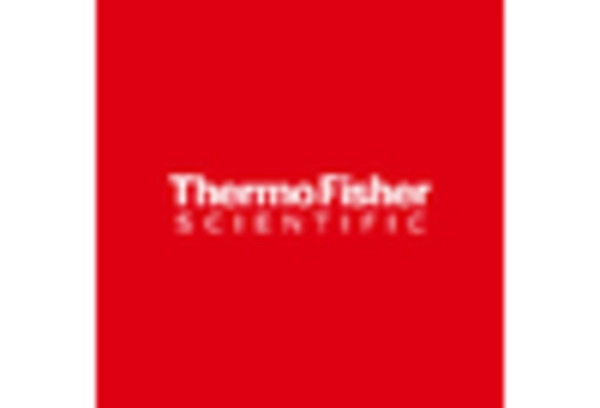Rising Prevalence of Chronic Diseases
The increasing incidence of chronic diseases in the US is a pivotal driver for the automated cell-counters market. Conditions such as diabetes, cancer, and cardiovascular diseases necessitate regular monitoring of blood cell counts, thereby propelling demand for automated solutions. According to the Centers for Disease Control and Prevention (CDC), chronic diseases account for 7 of the 10 leading causes of death in the US, highlighting the urgent need for efficient diagnostic tools. Automated cell counters provide rapid and accurate results, which are essential for timely medical interventions. As healthcare providers seek to enhance patient outcomes, the reliance on automated cell-counters is likely to grow, indicating a robust market trajectory. This trend underscores the critical role of automated cell-counters in managing chronic health conditions effectively.
Rising Demand for Point-of-Care Testing
The growing demand for point-of-care testing (POCT) is a notable driver for the automated cell-counters market. POCT allows for immediate diagnostic results at the site of patient care, which is increasingly favored in various healthcare settings, including clinics and emergency departments. The convenience and speed of POCT are appealing to both healthcare providers and patients, as they facilitate timely decision-making. The US market for POCT is anticipated to expand at a CAGR of 8% over the next few years, indicating a robust shift towards decentralized testing. Automated cell-counters play a crucial role in this trend by providing rapid and accurate cell counts, essential for effective patient management. As the healthcare landscape evolves, the integration of automated cell-counters into POCT frameworks is likely to enhance diagnostic capabilities and improve patient outcomes.
Technological Integration in Healthcare
The integration of advanced technologies in healthcare is significantly influencing the automated cell-counters market. Innovations such as artificial intelligence (AI) and machine learning are being incorporated into cell counting systems, enhancing their accuracy and efficiency. These technologies enable real-time data analysis and predictive analytics, which are crucial for patient management. The US healthcare sector is increasingly adopting these technologies, with a projected growth rate of 15% in AI applications by 2026. This technological evolution not only streamlines laboratory processes but also improves diagnostic capabilities, making automated cell-counters indispensable in modern medical practices. As healthcare facilities strive for operational excellence, the demand for technologically advanced automated cell-counters is expected to rise, reflecting a transformative shift in laboratory diagnostics.
Increased Focus on Laboratory Efficiency
The emphasis on improving laboratory efficiency is driving the automated cell-counters market. Laboratories are under constant pressure to reduce turnaround times and enhance productivity while maintaining high-quality standards. Automated cell-counters streamline the counting process, significantly decreasing the time required for results. This efficiency is particularly crucial in emergency settings where timely diagnosis can impact patient outcomes. The US laboratory market is projected to grow at a CAGR of 6% through 2027, reflecting the increasing need for efficient diagnostic solutions. As laboratories seek to optimize workflows and reduce operational costs, the adoption of automated cell-counters is expected to rise, reinforcing their importance in modern diagnostics. This focus on efficiency aligns with broader trends in healthcare aimed at improving service delivery.
Growing Investment in Healthcare Infrastructure
Investment in healthcare infrastructure in the US is a significant driver for the automated cell-counters market. The government and private sectors are channeling substantial funds into upgrading laboratory facilities and expanding diagnostic capabilities. According to the American Hospital Association, total hospital expenditures reached approximately $1 trillion in 2023, with a notable portion allocated to laboratory enhancements. This influx of capital facilitates the acquisition of advanced automated cell-counters, which are essential for efficient laboratory operations. As healthcare providers aim to improve service delivery and patient care, the demand for sophisticated automated cell-counters is likely to increase, indicating a positive outlook for the market. Enhanced infrastructure not only supports the adoption of these technologies but also fosters innovation in diagnostic methodologies.

















Leave a Comment